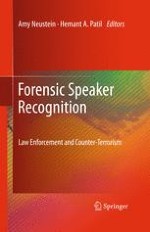2012 | OriginalPaper | Buchkapitel
15. Speaker Spotting: Automatic Telephony Surveillance for Homeland Security
verfasst von : V. Ramasubramanian, Ph.D.
Erschienen in: Forensic Speaker Recognition
Verlag: Springer New York
Aktivieren Sie unsere intelligente Suche, um passende Fachinhalte oder Patente zu finden.
Wählen Sie Textabschnitte aus um mit Künstlicher Intelligenz passenden Patente zu finden. powered by
Markieren Sie Textabschnitte, um KI-gestützt weitere passende Inhalte zu finden. powered by
